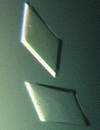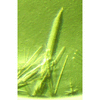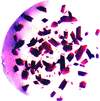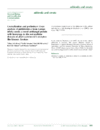issue contents
October 2007 issue

Cover illustration: Alzheimer's disease amyloid precursor protein copper-binding domain [Kong et al. (2007), Acta Cryst. F63, 819-824].
protein structure communications
An atomic resolution structure of the copper-binding domain of the Alzheimer's disease amyloid precursor protein is presented.
The structure of AKR1C21 holoenzyme was determined at 1.8 Å resolution. A model describing the interaction between AKR1C21 and steroid substrates is proposed that explains the bifunctionality of the enzyme.
PDB reference: 3(17)α-hydroxysteroid dehydrogenase, 2p5n, r2p5nsf
Binding of Ni2+ ions to the uncleaved affinity tag facilitated de novo phasing of the crystal structure of M. tuberculosis mtFabD to 3.0 Å resolution.
PDB reference: mtFabD, 2qj3, r2qj3sf
crystallization communications
PvuII is the first type II restriction endonuclease to be converted from its wild-type homodimeric form into an enzymatically active single-chain variant. The enzyme was crystallized and phasing was successfully performed by molecular replacement.
A 5S rRNA A-helix 7-mer oligonucleotide was chemically synthesized both as D-RNA and as L-RNA, biochemically investigated, crystallized as a stochiometric racemate and examined by X-ray diffraction.
The radixin FERM domain complexed with the CD44 cytoplasmic tail peptide has been crystallized. A diffraction data set from the complex was collected to 2.1 Å.
The crystallization of peanut allergen Ara h 3 is reported.
S. typhimurium uridine phosphorylase has been isolated and crystallized in the presence of ligand.
The ferredoxin component of carbazole 1,9a-dioxygenase from N. aromaticivorans IC177 was crystallized and diffraction data were collected to 2.0 Å resolution.
The human tRNAGly acceptor-stem microhelix was crystallized and preliminary X-ray diffraction analysis revealed diffraction to a resolution of up to 1.2 Å.
Bacillus anthracis arylamine N-acetyltransferase C (BanatC) is an enzyme that metabolizes the drug sulfamethoxazole. Crystals of the purified enzyme that diffract at 1.95 Å are reported.
Bacterial and insect cell expression systems have been developed to produce unglycosylated and glycosylated forms of human interleukin-7 (IL-7) and the extracellular domain of its α receptor, IL-7Rα. We report the crystallization and X-ray diffraction of IL-7 complexes to both unglycosylated and glycosylated forms of the IL-7Rα to 2.7 and 3.0 Å, respectively.
The first crystallization of a resuscitation-promoting factor has been performed. Multiwavelength anomalous dispersion experiments have been carried out to obtain experimental phases using data at 2.9 Å resolution from a selenomethionine derivative.
β-Alanine synthase catalyzes the last step in the reductive degradation pathway for uracil and thymine. Crystals of the recombinant enzyme from D. melanogaster belong to space group C2. Diffraction data to 3.3 Å resolution were collected and analyzed.
The N-terminal region (1–339) of the human FHOD1 protein has been crystallized in two different crystal forms. A crystal of the (C31S,C71S) mutant diffracted to around 2.3 Å resolution.
The SMU.961 protein from S. mutans was crystallized and preliminary characterization of the crystals, which diffracted to 2.9 Å resolution, shows them to belong to space group C2.
Crystals of the mature form of CzcE from C. metallidurans CH34 were obtained which diffracted synchrotron radiation to 1.96 Å.
The haemoglobins from low oxygen affinity species, sheep and goat are crystallized under unbuffered low-salt conditions to explore the possibility of obtaining new crystal forms.
DsrEFH from Allochromatium vinosum has been cloned, expressed, purified, and crystallized. A preliminary X-ray study of DsrEFH has been performed with a good quality crystal.
The crystallization and X-ray diffraction analysis of the fourth FAS1 domain of human BigH3 are reported.
Old yellow enzyme from Trypanosoma cruzi, has been crystallized using the hanging-drop vapour-diffusion method.
addenda and errata
Free 



 journal menu
journal menu

































![[publBio]](/logos/publbio.gif)






